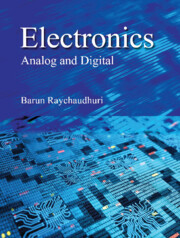Book contents
Chapter 13 - Digital Principles and Boolean Algebra
Summary
The working principles of computers and other digital systems are based on binary and hexadecimal number systems. This chapter introduces different number systems, such as binary, octal, and hexadecimal, and their relationships with our familiar decimal system. Some popular digital codes are also mentioned briefly. Arithmetic operations with binary numbers, development of algebraic techniques with Boolean variables and simplifications of Boolean expressions are illustrated. Indeed this chapter deals with the mathematical and theoretical portion of the digital system. All practical implementations with electronic circuits are included in the subsequent chapters.
The Digital System
The word ‘digital’ originates from digit, meaning separate organs or components like fingers of human hand and each of the keys of a keyboard. In electronic operations, the digit represents two discrete electrical states, such as on/off conditions of a switch or presence/ absence of voltage at a terminal. In the present context, digital refers to those electronic circuits which realize binary numbers in terms of two discrete voltage levels and perform mathematical and logical operations based on the principles of Boolean algebra.
Analog and Digital
The word ‘analog’ is derived from the Greek word analogos, which means ‘according to a certain ratio’. The computation with the operational amplifier, as explicated in Chapter 11, is analog in nature because the voltage values are analogous to numbers. The increment and decrement of numbers is in proportion to the voltage. The following characteristics are the major demarcations between analog and digital systems.
• Continuous and Discrete: An analog device consists of continuously changing quantity. For example, a continuous curve in XY-plane is an analog graph. The voltage change in operational amplifier is continuous. In contrary, a bar chart can be treated as a digital graph. The digital electronic circuits handle only two discrete levels of voltage.
• Size-Dependent Accuracy: The precision of an analog instrument depends on its size, marking of scale and other physical parameters. The least count of a slide calipers and that of a travelling microscope are different. A small size transistor has less power handling capability than that of a larger one. In contrast, the accuracy of a digital instrument does not depend on its size.
- Type
- Chapter
- Information
- Electronics , pp. 460 - 509Publisher: Cambridge University PressPrint publication year: 2023

